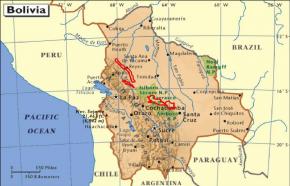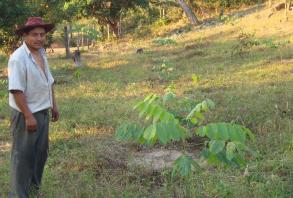Ethical investments
Plantation forestry with nature conservation and livelihood improvement
ArBolivia
The project
In 2007 Sicirec started the ArBolivia project in Bolivia. In this project 2,000 smallholders plant 5,000 hectares of their own land with high quality, predominantly indigenous tropical hardwood tree species.
Additionally, some 1,000 hectares are designated for agroforestry and, in conformity with the Sicirec Formula, 1,200 hectares as permanently protected nature reserve. The total project area thus covers 7,200 hectares.
The project areas are located at the foot of the Andes and on the edge of the Amazon Basin in various Bolivian provinces.

The project greatly improves the smallholders' income. Although the smallholders participate in the project with only a small part of their property, ArBolivia develops a land use plan for their full property. Moreover, training and advice are important aspects of the project.
In 2009 the first subsection of the project was registered with the United Nations as a Kyoto-project. As of May 31, 2011 ArBolivia has also been registered as a Plan Vivo project under project ID PV_2011_006.
In January 2010 ArBolivia, as the first and only foreign plantation forestry project, received the “Green Status” from the Dutch government. It therefore now officially qualifies for green loans from Dutch investment bank “green funds”. Green loans are provided at very low interest rates and are therefore a very attractive financing instrument for the project.
In the first three planting seasons some 1,500 hectares of forest plantation have been planted. The project structure is now well enough developed to be able to plant between 1,000 and 2,000 additional hectares annually.
For further information you may also visit the project web site.
The investment
In the coming years, the ArBolivia project will plant an additional 3,500 hectares of forest plantations. The project is looking for new investors who will finance the production and planting of tree seedlings.

The participating farmers provide the land and take care of the annual maintenance of the trees. The investors and the farmers both receive 50% of the net timber-revenues.
Based on a realistic scenario, the funding still needed amounts to $10.2 million. From this amount, $2.6 million will be covered by tree planting subsidy, carbon credit sales, and income from other environmental services, $3.5 million will be covered by bank loans and $0.7 million by timber revenues.
This means that only $3.4 million of the total amount needed has to come from equity investors. The price for 100% of one whole hectare thus amounts to approximately $2,300.
Based on conservative estimations and depending on the actual equity amount needed, the internal rate of return for the investors will be in the range of 13% to 22% per year over a period of 40 years. The return may even be higher in case of future timber price increases for tropical hardwood or in case of additional income through environmental services sales.
The project is known for its innovative character and leads to an improved income position for the participating smallholders, the use of improved agriculture techniques and sustainable planning of land use.
Ecological repair and permanent protection of ecological pockets and corridors are important spearhead actions for the project.
Further information you'll find in the general project presentation and the information memorandum.

